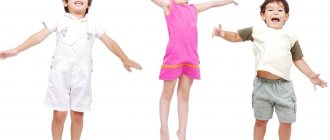Every person goes through age-related crises in his life. Since children develop quickly, their crises are more vivid and noticeable. The crisis of three years in a child is considered one of the most intense during the period of growth. Until recently, the baby was calm and affectionate, listened to adults and followed the established rules. And now he begins to protest against the previous way of life, try to separate from his parents, and defend his rights to independent existence. He is mischievous, screams, cries if something doesn’t work out or something is denied.
The main advice for parents is to remain balanced when communicating with the baby, and then after the end of this difficult period the baby will also become calmer, independent and reasonable.
What is the three-year-old crisis?
The three-year crisis in children is a period of life in which they acquire a huge number of new personal formations. The baby psychologically separates from his mother, strives for independence, and reaches a new level of communication with adults and peers. He wants to be “like big,” but he can’t do much yet due to his age. As a result of this dissonance, the child develops hysterics, resentment, and “deteriorates” in behavior. In short, the crisis of three years is a period of rapid development.
Stubbornness
Stubbornness and perseverance are two different things that should not be confused with each other. Persistence is about the manifestation of will, which allows the child to achieve his goal. But a stubborn child will stand his ground only because he has already demanded it before.
Let's take a closer look at the difference between stubbornness and persistence:
- Persistence. The child flatly refuses to sit at the table because he has not completed the tower of blocks. And it keeps collapsing.
- Stubbornness. If a mother calls her child for breakfast, but he refuses. And before that he said that he was not hungry. In fact, he was hungry and wouldn’t mind having something to eat.
What to do in this case? You shouldn’t try to convince your baby and continue to persistently call him for breakfast. The right solution is to leave food on the table and tell your child that he can eat when he is hungry.
Causes of child crisis 3 years
According to the theory of L.S. Vygotsky, a child’s growing up is an alternation of stable and crisis periods of mental development. In stable periods, the child develops slowly and linearly, in periods of crisis - rapidly and spasmodically. One of the main causes of the crisis is the child’s conflict with the outside world. He wants to do everything on his own, but he is prevented from doing this by circumstances that he cannot influence, for example, adult prohibitions and an insufficient level of knowledge and skills.
Factors influencing the intensity of crisis manifestations:
- Type of nervous activity. Children with a weak or unstable type - melancholic and choleric - are more likely than others to throw tantrums, be capricious and protest against the rules during a crisis. Phlegmatic and sanguine people have an easier attitude towards obstacles in their lives and usually behave a little more calmly.
- Authoritarian parenting style in the family. If parents constantly suppress the child’s impulses for independence, then he resists this more than if this does not happen.
- Anxious type of parenting and overprotection. In such a family, the child’s independence is also suppressed, only for other reasons: the parents consider him a very small child who cannot do anything on his own. Protests and hysterics in this case are inevitable.
- Tensions in the family. If conflicts often occur between parents, then the child unconsciously tries to attract attention to himself. He practically fails to do this, so the crisis of three years manifests itself more intensely.
- Health status. Children with mental and neurological developmental disabilities experience an age-related crisis much more acutely than their healthy peers.
Gender characteristics
When overcoming the crisis period of this age, parents should take into account the gender characteristics of their children.
Girls
By the age of 3, they speak much better than boys, so during a crisis they use their verbal abilities for manipulation. In this they must be immediately limited: clearly define what is permissible to say and what is not.
Girls have well-developed auditory perception, so she needs to say all requests loudly and clearly.
Girls are more emotional, which is why they are the ones who most often throw tantrums and act up during a crisis. Given this psychological feature, parents need to direct their overwhelming emotions in the right direction. For example, delegate some of the household chores, get involved in modeling or drawing.
Boys
By the age of 3, boys cannot always express their overwhelming emotions in words. Therefore, they result in aggression and isolation. To prevent this, talk to your baby every day about what happened, what he feels and what he wants.
Boys have well-developed visual perception, and they ignore half the information. Therefore, it is better to show him everything clearly. Don’t waste time saying “Put the toys away!”, but bring them to them and show them where to put them.
By the age of 3, boys already develop a need to explore the world around them. Therefore, they run around a lot, look into every basement and open hatch, climb trees and fences, put something in sockets, disassemble (= break) household appliances. To avoid injury, parents must clearly define territorial restrictions for them.
How does the 3 year crisis manifest itself?
External signs of a 3-year-old crisis are usually noticed by parents: the child becomes capricious, argues, stops listening, and may throw a tantrum in the street because of some little thing. Psychologists L.S. Vygotsky and A.A. Leontyev identified 7 main symptoms of a crisis in a child’s 3rd year. In each child they can manifest themselves to varying degrees and in different situations.
Negativism
This is the name of the symptom, which consists in the child’s refusal to do as the adult said. Moreover, refusal to fulfill a request often does not even correspond to the child’s own desires. For example, a mother invites the baby to go for a walk, but he refuses only because it is an adult’s initiative. An interesting feature is that if the parent decides to say “well, okay, then we won’t go for a walk today,” then the child will most likely quickly change his mind and decide that he still wants to go outside. That is, he will again do something different from what the adult said.
Obstinacy
The child refuses to continue following the usual daily routine. For example, if after waking up he always went to brush his teeth and wash his face, and then have breakfast, then in a crisis period he can begin to win his right to first eat, and then go for hygiene procedures.
Stubbornness
The child, who is in a three-year-old crisis, makes his decisions and is not going to cancel them. For example, if he said that he will not tidy up the toys, he will not do it. Even if at the same time the mother gets angry and puts them in the trash. The child will cry, but will not change his decision: he will not clean up.
Self-will
The child tries to do everything on his own, but does not listen to adults who are trying to help him. If a baby fastens his buttons and allows his mother to show him how to do it correctly, then this is simply a desire for independence. When he pushes mother’s hands away, doesn’t let her say or show anything, cries and shouts “I do it myself,” but does everything wrong, then this is self-will.
Protest
Most often it arises against the backdrop of frequent orders from parents about what a child who is in a 3-year-old crisis should do. The kid protests against adults deciding for him. For example, a child completely refuses to read a book at night if the mother chose the fairy tale herself and did not give him the choice.
Depreciation
The baby stops appreciating what he previously considered important and dear. For example, he breaks his favorite toys, tears up books. Significant adults may be devalued, and then the child may call mom and dad names, fight with older brothers and sisters, with whom he previously had excellent relationships.
Despotism
The child is trying to begin to command in the family, wants to be listened to and obeyed. For example, he can order his parents to turn on cartoons right now, despite the fact that they are busy with other things. If they don’t listen to him, then he screams and cries, stamps his feet and continues to demand.
The crisis of three years is manifested by the listed symptoms to one degree or another in every child, but not all of them are manifested so clearly for parents to notice. Sometimes the crisis of three years is limited only to stubbornness and negativism, and in some cases all seven symptoms are clearly visible.
We fight whims
The biggest problem in the 3-year-old crisis is the frequent whims and hysterics of stubborn little ones. To avoid hysterics and whims, you should discuss your actions with your children in advance. Just because you're shopping for dinner doesn't mean you have to buy a new toy. Talk to your child, explain where you are going, ask his opinion.
If the child has already started to become hysterical, do not start screaming and threatening, remain calm. Kids love to throw tantrums in a crowded place; take your capricious child to a quiet corner where there will be no spectators. Don't start lecturing and raising children in the presence of other people. The best thing to do is hug your baby. Tell your child how much you love him, and also how this fidgety behavior upsets you.
Under no circumstances resort to physical or corporal punishment. The little man will only become embittered, his stubbornness can only increase. The baby will begin to be afraid of its parents. Never insult your child, do not call him a bungler or a hooligan. Praise for all successes. Don't make fun of failures. At this age, many children develop new fears that the baby will not be able to cope with on their own. Children begin to be afraid of heights, darkness, fear of strangers and vast spaces.
How we survived the crisis
Olga, 28 years oldSon Makar, 4 years old
My son has been naughty since childhood, but until he was 2 years old, everything was limited to refusing soup and unwillingness to put away toys, I remember from myself that this is normal. And when we sent him to kindergarten, something unimaginable began. Screams and hysterics in the morning, teachers constantly complained that he did not go to play, offended other children, and did not eat at all. We were seriously scared then and took Makar home for several months, I took a vacation, and my husband and I took turns studying at home, trying to figure out how to overcome the crisis. Of course, at first I swore, screamed, could have spanked him, but the howling only became louder, and then we decided to act in two ways - an agreement and ignoring
It was possible to ignore the hysterics, Makar became calmer when he realized that he would not achieve anything in this way, he himself began to compromise. As a result, after three months we calmly returned to kindergarten, and by the age of 4 even whims became a rarity for us
Result of the crisis
The 3-year crisis in psychology is an important period in the development of a child’s personality. When it ends, the psyche reaches a new level of development. According to the theory of L.S. Vygotsky and A.A. Leontiev, the following areas of a child’s life change:
- Leading activity is an activity within which other forms of activity appear and differentiate, private mental processes are restructured and personal new formations arise. After the crisis, the child begins to develop a completely new leading activity - role-playing game, in which he begins to explore the world of relationships between people.
- The social situation of development is a system of social conditions that influence the internal development of the child. After a crisis, the child’s communication with peers gradually comes to the fore, and the adult becomes a role model in role-playing games.
- Personal new formations arise. After the three-year crisis, the child develops self-awareness, pride in his achievements, and independence.
Despite the fact that the 3-year-old crisis causes a lot of trouble for parents, it is a mandatory stage in a child’s development. Having overcome it, the child becomes different: independent, conscious, reasonable, begins to understand and be able to do more. Without personal crises, the child would not be able to separate from his mother in time, realize himself and understand what he is capable of, what he wants and what he can do, and what remains to be learned.
Maturation of the personality of a three-year-old
Overcoming the crisis fits within the age range of 2-4 years. The peak moment occurs at age 3. The child needs to realize his own strengths. The first thing the baby does on this path is to explore the capabilities of his body: he jumps, climbs, takes different poses, manipulates objects in the adult world, actively learns about technology and electronics, and masters his first real (three-wheeled) bicycle.
Normally developing children experience pleasure from their expression of will. They contrast their own needs and the demands of adults openly and as if out of spite. Stubbornness is a negative but necessary form of behavior.
Having overcome the conflict of interests, little men learn their first compromises.
How to survive a child's 3-year-old crisis
Advice to parents from a psychologist on how to behave with a three-year-old child in crisis:
- Be patient. You should not try to put pressure on the baby during a hysteria, shout at him or threaten him with punishment. These actions can have the opposite effect: the more the child perceives obstacles, the more intensely he fights them.
- Agree. For example, knowing that a child might throw a tantrum in a store, agree to buy one thing for him, and say that if he starts being capricious, then you will have to leave the store. And be sure to comply with these conditions. If everything went well, then you need to praise the baby for his worthy behavior.
- Set boundaries. The baby must clearly know what he can and cannot do. However, the ban cannot be lifted because the child cried. It's better to talk to him about what happened after he calms down. Speaking out the current situation on your own also helps the child calm down.
- Limit the use of the word “impossible.” The more a child is forbidden, the more he wants to try and check. As a result, the baby will protest and defend his rights. During a three-year crisis, it is reasonable to prohibit doing only the following:
- harms the health of the child himself;
- threatens other people or animals;
- leads to damage to truly valuable property.
- Give the child more independence. Let him check for himself: is it cold outside in winter in sandals? It will take many times less time and nerves for him to go outside and realize that he is cold than to persuade a three-year-old to put on felt boots rather than sandals.
- Be consistent. Be sure to keep your promises - both positive and negative. The baby should know: if mom said that after kindergarten there will be a walk in the yard, then it should take place; and if she said that she wouldn’t give him sweets if he didn’t eat the soup, then he really wouldn’t get any sweets. You cannot prohibit a child from doing something and then allow it a few minutes later, and vice versa.
- Name the child's feelings. This leads to his awareness of his condition. Tell him “you’re angry now because...”, “you’re offended because...”. By the end of the crisis, instead of hysterics, the child himself will learn to say “I’m upset because I couldn’t make a road for the car.”
- Relieve mental stress. Drawing, playing with sand, modeling from plasticine and dough, and playing with water are great for this.
- After a quarrel with a child, when he has already calmed down, it is imperative to restore contact with him. Hug, tell him how good and beloved he is, stroke and caress him. This is important for maintaining emotional contact with the child in the future.
Recommendations from Komarovsky
A popular doctor gives three tips to parents on how to survive a child’s 3-year-old crisis.
- As few restrictions as possible. The word “no” should be uttered only if it is truly critical for the child or other people. Otherwise, it will no longer be perceived as a signal of danger, and the child will stop following it. And this can lead to trouble.
- Unity of the education system. All adult family members must agree on the rules so that the child does not have the opportunity, having received a ban from one of them, to persuade the other to allow it. If you can’t eat sweets before lunch, then no one should allow it: not dad, not mom, not grandma.
- Constancy of rules. The child must know that the rules always work, every day. If today your child is allowed not to tidy up his toys before bed, then tomorrow it will be extremely difficult to persuade him to do so.
Dr. Komarovsky also believes that the 3-year-old crisis is a normal period in a child’s development, during which parents should know how to cope with it and help them grow up.
Important tips for parents
Always remember that the behavior of a young man, his whims and rebellion do not come from character. All these are events necessary for the psyche, through which the child’s personality and its emotional-volitional sphere are formed.
The three-year-old rebel wants to be an adult, to participate in the life of the family on an equal basis with others. So that his self-esteem is formed in accordance with his age, and his character remains peaceful, learn to take his opinion into account: in choosing a dish for breakfast, clothes for a visit, a gift for a neighbor’s girl, toys for a walk. A reminder to parents on raising a 2.5-4 year old child consists of just a few points.
Memo for parents on raising children 2.5-4 years old
Reasonable prohibitions. Do not overload the space with many prohibitions. It is better to establish safety rules and establish any requirements from this position. “You can’t be the first to leave the entrance because something might fall from the roof (icicles)/someone will be knocked down (boys on bicycles)/the door is too heavy (it might hurt).
Calmness and resourcefulness. Stay calm and reasonable. Be resourceful. Learn to turn the situation to your advantage. Make truthful arguments. Make fun of minor problems
Switch the capricious person’s attention to something. Look for compromises.
Praise and Choice
Praise for independence in permitted situations. In all other cases, offer an imaginary choice: do not ask if he wants to bathe, ask what shampoo he will use today.
With the permission of your elders, anything is possible. Come up with games and activities in which prohibitions are broken at the request of adults: whatman paper for drawing on top of the wallpaper with your younger sister, a basin of warm water for launching boats with your dad. From time to time, allow harmless “mischief” and do it with your children.
Involvement in activities. Use role-playing games to engage in activities. Place the bear at the table and start feeding. Ask your daughter to help with this. You won’t notice how she will pull the spoon into her mouth.
Anticipating the situation. Anticipate tantrums and agree on behavior in advance. And never compare your children with others. The maximum is with them in the past. Comparison with others undermines the development of self-esteem. Learn yourself and teach your children how to make pleasant surprises. Receiving gratitude is much more pleasant than punishment.
No physical punishment. Extinguish attacks of anger! Deprivation of promised entertainment is also ineffective as punishment. This will only undermine trust in the parent. Punishment should not be directed from parent to child. The best punishment is one that comes from the situation and is aimed at behavior in this situation, that is, impersonal punishment (something broke, became unattainable, got lost, disappeared).
Know how to distinguish between intentional evasion of rules and accidental violation of them in cognitive courage. In every situation, have the restraint to figure it out and not scream. The child who broke the cup may end up having to be praised while at the same time expressing disappointment over the cup. Soften critical remarks as much as possible, and it is completely incorrect to insult a preschooler.
Another note relates to sudden changes in children's behavior. Sometimes it is not a psychologist, but a neurologist who comes to the aid of the family of a disobedient preschooler. When behavioral disorders arise from the physical quality of the nervous system, educational principles are supplemented by medical ones.
Disobedience is no longer seen as a problem, but as a symptom. A neurologist may recommend sedatives. You shouldn't neglect them.
My experience of working with a three-year-old child during a crisis
One of the kids in kindergarten showed all the “seven stars of crisis.” His name is Bogdan, he started going to kindergarten at the age of two. In the middle of the year, the child’s mother began to tell the teachers about the child’s serious changes in behavior. He doesn’t want to go to kindergarten, although he always went with joy, he refuses to have breakfast, his favorite answer to all questions is “no.”
After some time, he began to show his condition in kindergarten: he could break his car, quarreled with his peers, and refused to nap during the day. At the same time, he wanted to perform any action himself, regardless of whether he succeeded. He did not accept help from adults.
This state lasted for about six months. A consultation was held with the teachers and mother about the 3-year-old crisis, recommendations were given on how to interact with the child: give more independence, do not scold, support, talk and explain everything that is happening to him. After about six months, the hysterics became less frequent and intense, reasonableness appeared, and Bogdan learned a lot. Soon his mental state stabilized, he became calmer and more balanced.
Help from pets
Buying a pet and sharing the responsibilities of caring for it among family members (or children of different ages) is a good way to balance relationships and shift the focus from the self-centered child self to the defenseless ego of a living being.
The ideal choice for a three-year-old child would be a cat. Naturally, from good parents with adequate behavior. A wild street kitten will not be suitable, since the pet should calm you down and put you in a completely different mood. You should choose a breed based on its habits, not its appearance. Among 40 cat breeds you can find a pet for every taste.
Not only the breed is important, but also how the cubs grew, how much they interacted with humans, and what they managed to learn by the time they were 2 months old at the time of sale. A good pet will teach a three-year-old a lot: to arrange a comfortable environment in accordance with the needs of another, to cope with cleaning, to worry about the health of a pet, to raise it.
In terms of mental characteristics, a two-month-old kitten and a three-year-old preschooler are approximately equal, so they understand each other perfectly. The cat will grow up faster and remain a family friend. And during this time, the preschooler’s crisis year will end. The child will learn the basics of responsibility and interspecies friendship.
A 3-year crisis can last from six months to two years and is characterized very individually. Children are so different that one will be mischievous all this time, and the other will “get over it” in 2-3 weeks. Parents need patience not to lose their temper.
Take the 3-year crisis not as a terrible test, but as confirmation of normal development and personality formation. Time passes quickly, an obedient child will soon return if you are careful enough in your own actions. Relationships with parents are built continuously. If contact is lost, it is difficult to restore it at subsequent age stages.
Did you like our content? Subscribe to the channel in .











